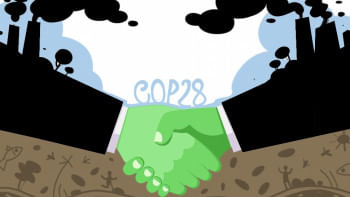Monitor groundwater to manage it better

The fact that the global climate crisis is essentially a water crisis is clear to see. Climate action thus requires strong commitment to better managing this essential resource. And being the largest store of fresh and unfrozen water, globally, groundwater plays a significant role in our adaptation to climate change and variability.
Specifically in Bangladesh, groundwater is an important natural resource upon which our water and food security is critically dependent. Bangladesh extracts approximately 32 km3 of groundwater every year, which is five times the volume of water in Kaptai Lake. In terms of functional use, groundwater provides for 98 percent of drinking water and almost 80 percent of all irrigation water supply in the country. Still, groundwater has not received the proportionate level of attention when it comes to policy and practice.
Climate change, coupled with anthropogenic land-use practices (for example, irrigation), is putting a huge amount of pressure on Bangladesh's groundwater resources. However, we are largely unaware regarding the two factors due to which climate and anthropogenic changes impact groundwater sources: demand-led pressure and lack of supply.
Demand for freshwater has been increasing in Bangladesh since the 1980s due to population growth, economic development, industrialisation, urbanisation, and food production. These demands have inevitably put pressure on groundwater storage and availability over the decades.
The availability of seasonal groundwater is increasingly becoming unpredictable as a result of the changing pattern of monsoon rainfall. An analysis of rainfall time-series data from the Bangladesh Meteorological Department reveals increased variability in monsoon rainfall, with long-term decline in rainfall in the centre of Bangladesh. A report published in this newspaper in August 2023 suggested that the lack of sufficient rainfall was forcing farmers to pump groundwater to irrigate Aman rice—a crop which is normally rain-fed and makes up almost 40 percent of total rice production. To note, the completely irrigated dry-season Boro rice crop contributes 54 percent to the total rice production of Bangladesh. The fact that Aman rice now requires irrigation in the middle of the rainy season is clearly a result of climate change and also a sign of forced adaptation. This also presents a water management challenge for the country. A dip in monsoon rainfall will lead to reduced river discharge, thus affecting navigation, aquaculture, and biodiversity.
Insufficient supply of storage for groundwater is due to the changing seasonality (timing) and magnitude of replenishment or recharge. Normally, shallow groundwater in most parts of Bangladesh is renewed or replenished every year during monsoon. Groundwater reaches its deepest (annual deepening) during the early summer period (March-April), which coincides with the period of highest temperature as well as demand for Boro rice cultivation. Groundwater levels start to rise (annual shallowing) during the monsoon season when water-use for irrigation ceases and rainfall starts to recharge the seasonally drained aquifers.
The time taken for groundwater to be replenished has extended over time. Low rainfall during peak monsoon (June-July) might have been already impacting the annual recharge process as groundwater takes longer to replenish. It is challenging to determine the impact of climate change and variability on groundwater recharge in a system that is highly influenced by anthropogenic activities such as irrigation and industrial use. Further research is necessary to characterise this process and determine the impact of climate change alone on changing groundwater storage and recharge patterns.
We do know that it is due to climate change that we are seeing heavier rainfall events and slightly higher rainfall during the early monsoon period (often leading to flash floods). While it is well-established that episodic, heavy rainfall events lead to enhanced groundwater recharge in drylands in the tropics, we know less about the impact of these heavier rains in humid and monsoon climates such as that in Bangladesh. It is generally understood that heavy rainfall on desiccated lands following the dry season can lead to more overland flow and flooding, which may not favour groundwater recharge particularly in the Madhupur and Barind Tracts. Additionally, an increased evapotranspirative demand during the early monsoon season may decrease groundwater recharge in the warmer climate of Bangladesh.
So, what kind of water adaptation should Bangladesh consider to cope with the impacts of climate and anthropogenic changes? In the face of the climate crisis, protecting groundwater resources is crucial to maintain the supply of water for drinking and irrigation. This does not mean that groundwater cannot be used more sustainably and prudently. Dependence of groundwater is continuously increasing to meet irrigation and industrial water demands across the country, and this dependence is unlikely to decrease in the future.
The problem with management is the lack of data on groundwater abstraction. A resource cannot be managed if it is not monitored properly. While estimating water use for irrigation is possible using information collected by the Bangladesh Agricultural Development Corporation, there is no information on privately managed industrial water usage. This needs to be addressed by the government sooner than later.
To manage groundwater sustainably, farmers need to diversify crop types so that they are not forced to irrigate both Aman and Boro rice. Thankfully, this is already happening in some parts of the country, particularly in the Barind Tract region where farmers are moving towards vegetable and cash crops such as mangoes of their own accord. In order to encourage more farmers to go this route, government support is needed to accelerate crop diversification. This of course must be done in consultation with farmers so that they are part of the decision-making process.
The combined use of surface water and groundwater should be promoted where possible. The availability of surface water in Bangladesh is seasonal, which is a crucial factor that water management strategies need to factor in. Groundwater, which is contaminated by arsenic and salinity in some regions, needs to be protected at any cost as the primary source of drinking water in Bangladesh.
At the moment, various government agencies monitor groundwater with their own network, but there is a lack of coordination or willingness to share data across departments. Plus, monitoring infrastructures are not regularly maintained beyond project lifetimes.
Despite its centrality to water and food security in Bangladesh, groundwater is not prominently featured in national water policies. Bangladesh first needs to develop its own groundwater policy. Our research and monitoring capacity regarding groundwater needs to be strengthened by founding separate groundwater-focused research and policy centres that will work closely with academics and practitioners.
Dr Mohammad Shamsudduha is associate professor at the Institute for Risk and Disaster Reduction of University College London. Reach him at [email protected]
Views expressed in this article are the author's own.
Follow The Daily Star Opinion on Facebook for the latest opinions, commentaries and analyses by experts and professionals. To contribute your article or letter to The Daily Star Opinion, see our guidelines for submission.

 For all latest news, follow The Daily Star's Google News channel.
For all latest news, follow The Daily Star's Google News channel. 











Comments